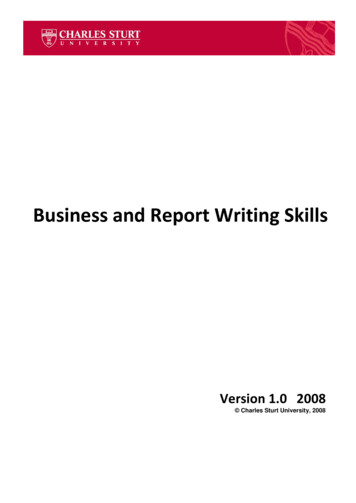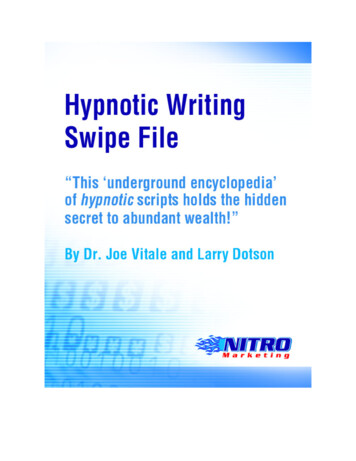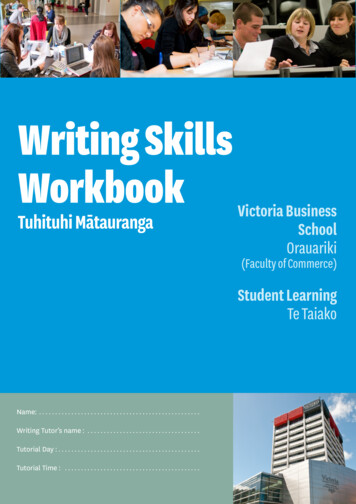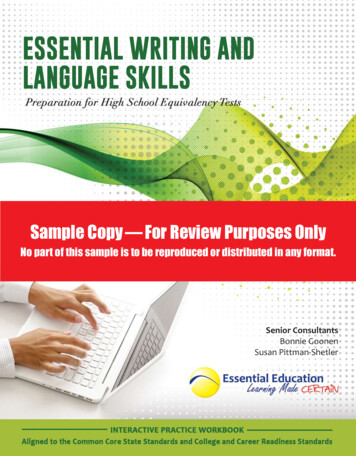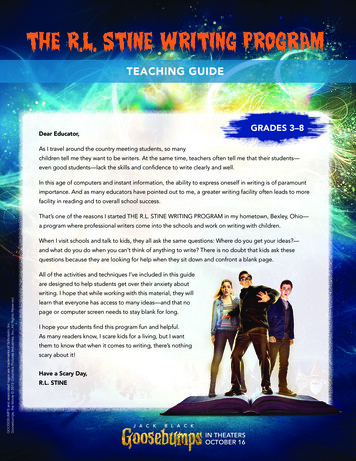
Transcription
THE R.L. STINE WRITING PROGRAMTEACHING GUIDEGRADES 3–8Dear Educator,As I travel around the country meeting students, so manychildren tell me they want to be writers. At the same time, teachers often tell me that their students—even good students—lack the skills and confidence to write clearly and well.In this age of computers and instant information, the ability to express oneself in writing is of paramountimportance. And as many educators have pointed out to me, a greater writing facility often leads to morefacility in reading and to overall school success.That’s one of the reasons I started THE R.L. STINE WRITING PROGRAM in my hometown, Bexley, Ohio—a program where professional writers come into the schools and work on writing with children.When I visit schools and talk to kids, they all ask the same questions: Where do you get your ideas?—and what do you do when you can’t think of anything to write? There is no doubt that kids ask thesequestions because they are looking for help when they sit down and confront a blank page.All of the activities and techniques I’ve included in this guideare designed to help students get over their anxiety aboutGOOSEBUMPS and associated logos are trademarks of Scholastic Inc.Goosebumps, the Movie 2015 Columbia Pictures Industries, Inc. All Rights Reserved.writing. I hope that while working with this material, they willlearn that everyone has access to many ideas—and that nopage or computer screen needs to stay blank for long.I hope your students find this program fun and helpful.As many readers know, I scare kids for a living, but I wantthem to know that when it comes to writing, there’s nothingscary about it!Have a Scary Day,R.L. STINEJ A C KB L A C KIN THEATERSOCTOBER 16
OVERVIEW FOR TEACHERSHOW TO USE THIS PROGRAMTIME REQUIREDStudents can complete each section of THE R.L. STINE WRITING PROGRAM in two class periods per week. Oryou may decide to use the program as an intensive two-week class activity culminating in the students writingtheir own stories.PROGRAM COMPONENTSTHE R.L. STINE WRITING PROGRAMconsists of seven fully reproducibleactivities designed for use withgrades 3–8.GETTING STARTEDStudents can work independently, in small groups, or together as a class on the activities in the writing program.You may want to introduce the program by leading the class in a discussion about the writing process. How dowriters get their ideas? What makes a story interesting? Then distribute the first activity sheet.THE R.L. STINE WRITING PROGRAM has been designed to help students overcome their anxiety aboutwriting by providing a writing process that can be followed in a step-by-step manner. Popular author R.L. Stinegives tips and strategies for finding ideas to write about, developing characters and plots, and revising. Thereare short writing activities throughout to help students gain confidence and proficiency in writing.NATIONAL STANDARDS GUIDELINESThe Writing Program correlates with the following standards for English Language Artsdeveloped by NCTE and IRA:Students read a wide range of print and non-print texts to build an understanding of texts, of themselves, and of the cultures of theUnited States and the world;Students apply a wide range of strategies to comprehend, interpret, evaluate, and appreciate texts;Students adjust their use of spoken, written, and visual language (e.g., conventions, style, vocabulary) to communicate effectivelywith a variety of audiences and for different purposes;Students employ a wide range of strategies as they write and use different writing process elements appropriately to communicatewith different audiences for a variety of purposes;Students apply knowledge of language structure, language conventions (e.g., spelling and punctuation), media techniques,figurative language, and genre to create, critique, and discuss print and non-print texts;Students develop an understanding of and respect for diversity in language use, patterns, and dialects across cultures, ethnicgroups, geographic regions, and social roles;Students participate as knowledgeable, reflective, creative, and critical members of a variety of literacy communities;Students use spoken, written, and visual language to accomplish their own purposes (e.g., for learning, enjoyment, persuasion, andthe exchange of information).J A C K2B L A C KIN THEATERSOCTOBER 16THE R.L. STINE WRITING PROGRAM
CONTENT AND DESCRIPTION OF ACTIVITIESPages 4–5: Welcome to THE R.L. STINE WRITINGPROGRAMR.L. Stine shares his tips on where ideas come from.Activity Completing a story begun by R.L. StinePages 6–8: Journal WritingStudents read and analyze a section from R.L. Stine’schildhood journal, then write and revise an entry oftheir own.Activities Finding an idea to write about Writing the entry Revising the entry using R.L. Stine’s editing andrevising techniquesPage 9: Remember When WritingAbout MemoriesStudents read a short memory piece by R.L. Stine,then write and revise a memory piece of their own.Activities Finding an idea by analyzing a list of R.L. Stine’smemories Using a strategy to find the focus of the piece Writing a memory piece Revising the piecePage 10: What If?Students are guided into writing fiction by workingfrom their journal entries or memory pieces and askingthe question What if?Activities Analyzing their own writing to find detailsor incidents that could be developed intofiction stories Writing a short creative writing piece Revising the entry Making a list of What if ideas they might useto write a storyPages 11–12: Meeting Your CharactersStudents read about how R.L. Stine comes up with hischaracters, then begin to develop characters for theirown stories.Activity Working from the list of What ifs they created inthe last activity, students create a “cheat sheet,”which lists major characteristics of the characterswho will play a part in their stories.Pages 13–14: Outlines and PlotsStudents read an outline for an R.L. Stine story, thenlearn how the outline helps to organize the basicelements of the plot of a story.Activities Completing a plot and outlining a story Writing the first draft of their final storyNote: Teachers may find this especially suited tosmall group work.Pages 15–16: Revising Your WorkR.L. Stine shares his tips and checklist for revisingeffectively.Activity Using the checklist to revise stories and createfinal draftsNote: Teachers may want to encourage students towork in pairs on the revision process.Page 17: R.L. Stine’s Top Ten Tips for CuringWriter’s BlockR.L. Stine shares his strategies.R.L. Stine would like to thank Michelle Berger,Facilitator of the Talented and Gifted Program, NorthShore Middle School, Glen Head, New York, for herguidance on this program.Note: Teachers of grades 3–5 may prefer to do onlythe last part of this page—making the list of What ifs.J A C K3B L A C KIN THEATERSOCTOBER 16THE R.L. STINE WRITING PROGRAM
STUDENT REPRODUCIBLEWELCOME!As I travel around the country visiting schools and talking to my readers,many kids tell me how much they want to write, but they have troublegetting started. They can’t think of an idea to get the story going.“Where do you get your ideas?” they ask me. It’s not an easy questionto answer. A friend of mine, who’s also a writer, answers thatquestion by saying: “I get my ideas at the Idea Store.”Too bad there isn’t really an Idea Store. Or is there? How dowriters get ideas? And how do we figure out how to make a storyinteresting, suspenseful, or funny?HERE’S A WRITING SECRET: There are three places that ideas come from. Let’s think of these asthe three departments of the Idea Store. The first department of the Idea Store is full of everything wesee and hear and find in the world around us. The second department is jam-packed with all of ourmemories. And the third department contains everything we don’t know about and haven’texperienced—things we wonder about.I GET MY IDEAS BY VISITING ALL THREE DEPARTMENTS OF THEIDEA STORE. LET ME GIVE YOU SOME EXAMPLES:Department One: EXPERIENCEOnce I saw a boy getting onto an airplane by himself. I watched him as he sat down and started to read aletter. Who was the letter from? What did it say? I don’t know, but it gave me an idea for a book.The main character has to leave home and live with her cousin. When she arrives, she finds a letter inher suitcase. The letter is from her mom. It tells her that she is about to begin a secret life—and shewill never come home again.Department Two: MEMORYFor another story, I remembered my favorite book, Something Wicked This Way Comes by Ray Bradbury.That book is about a very scary carnival. It gave me the idea for writing a book that starts in a carnival.In my story, a girl named Maggie goes to a fortune-teller at a carnival. The fortune-teller tells Maggiethat she is evil. Of course, Maggie doesn’t believe her—until the terrible accidents start Department Three: WHAT IF?I started wondering what it would be like to have a double—someone who looked just like you.And before I knew it, I had the beginning of a story about Ross and a boy who not only looks likehim—but says he is him!4THE R.L. STINE WRITING PROGRAM
STUDENT REPRODUCIBLEFINISH THE STORYIn this writing program, you and I will shop for ideas in all threedepartments of the Idea Store. I’m going to share some tips I’vepicked up about getting started, about characters and plots—andshare some of my secret techniques for revising your work. I’m alsogoing to share my top-ten list of guaranteed cures for writer’s block.HERE’S A STORY THAT I’VE JUST BEGUN. READ IT, THEN YOU FINISH IT FOR ME.DON’T WORRY ABOUT HOW YOUR ENDING SOUNDS. JUST WRITE DOWNWHAT YOU THINK SHOULD HAPPEN NEXT. BUT FIRST, LET’S HAVE SOME FUN.GHOST CARI poked my head into the old car. The dashboard was covered with dust, and the back of thepassenger seat was ripped and stained. “Why does Grandpa Ed keep this old wreck behind thegarage?” I asked my sister Ashley.“Ben, you know why,” she replied. “Grandpa thinks the car is haunted. He won’t go near it.”“Haunted? Cool,” I said. I climbed behind the steering wheel.“I’m outta here,” Ashley said. “I don’t like smelly, old cars—especially if they’re haunted.” Shedisappeared around the side of the garage.As soon as she was gone, I heard a soft whisper. “Ben . . . let’s go. Take me for a drive.”“Huh?” I gasped in surprise. I checked to make sure Ashley wasn’t playing a joke on me.But my sister had left.“Take me for a drive, Ben. I’m so lonely behind the garage.” The voice seemed to be coming fromthe radio. But the radio was turned off.I let out a startled cry as the engine started up. The car rattled and clanked, and then the enginehummed smoothly. “Step on the gas, Ben,” the voice whispered. “Don’t be afraid. Let’s GO!”My heart started to pound. I grabbed the door handle. Should I jump out of the car? I asked myself.Should I tell Ashley what’s happening?Or should I take the wheel? Step on the gas? Take a chance?5Do you need more space?You can use another sheet.THE R.L. STINE WRITING PROGRAM
STUDENT REPRODUCIBLEJOURNAL WRITINGWelcome todepartment oneof the Idea Store.How did you do on the story? It wasn’t so hard, right? The idea for the story wasright there. You didn’t have to start from nothing. Well, guess what? You don’tever have to start from nothing—if you remember to visit the Idea Store.Welcome to department one of the Idea Store. This is the department that’sfilled with everything we see and hear in the world every day. We’re going toshop here today but instead of collecting our ideas in a shopping cart, we’lluse a journal.Keeping a journal is a great way to build confidence in your writing,improve your ability to use description, and, most important, to get ideas.HERE’S AN ENTRY FROM ADIARY I KEPT WHEN I WAS 10.Sunday, August 3It’s really hot today. Bill (my brother)and I spent most of the day just lyingon the couch watching cartoons.Then after dinner—we had macaroniand hot dogs—we all piled into thecar so we could drive to the DairyQueen. Mom sat in the front holdingthe dog on her lap. Dino is so skinny.Miniature greyhounds are supposedto be skinny. It isn’t a very longdrive to the Dairy Queen, but Dinodoesn’t like the car so he’s whiningand crying. Then he starts to shakeand shiver. When we get to theDairy Queen, Bill and I get chocolatecones with sprinkles. My dad getsa milk shake and my mom gets avanilla cone. She gives it to the dog.The waitress looks angry. Dino lookspretty funny. He eats the whole coneand we go home.6NOW IT’S YOUR TURN!HERE ARE SOME IDEAS FROM THE IDEA STORETO GET YOU STARTED. TRY ONE OF THESE:1. Stand in one place for 10 minutes. Choose a placeyou go to often, such as the school library, or thedriveway of your house, or your apartment buildinglobby. Jot down everything you see, hear, and feel.2. Pick a special event that’s coming up for you:soccer game, birthday party, family trip, sleepover.The day of the event, jot down what happens.3. Pick one hour in your life and try to describeeverything you do, see, hear, and feel.Concentrate on gathering up as many details as you can.Don’t forget smells and tastes. They are part of the world.Write the details down in a list or as notes—whatever isfast and easy for you. Then write a first draft of your entry.Don’t worry about making the writing sound perfect.If you’re having trouble, try this trick: Tell the story outloud. Pretend you’re on the phone, telling a story to yourbest friend. Once you’ve told it out loud, it will be easyto get it on paper.THE R.L. STINE WRITING PROGRAM
STUDENT REPRODUCIBLEREVISING YOURJOURNAL WRITINGOnce you’ve written the first draft of your journal entry, you are ready to revise. Here’s my trickfor revising easily: Read your entry with a pencil in your hand. Make squiggle lines next to thesentences that just don’t sound right to you. Put *s next to the parts you like. Draw arrows fromthe parts that need more detail and write down any questions that occur to you.Before you work on your piece, let’s work on mine. I didn’t include detail and description.We want to know what Dino looked like when he ate the cone. Did Mom hold it for him? Wasthis a usual thing for the family? What did Bill and I think about this? Describing details andfeelings is the key to good journal writing.LET’S DO THIS TOGETHER WITH MY ICE CREAM JOURNAL ENTRY.ADD YOUR QUESTIONS AND COMMENTS TO MY MARKED-UP VERSION.How did it feel? Was ithotter inSunday. It’s really hot today. Bill (my brother) and I spent most the houseof the day just lying on the couch watching cartoons. Then after or cooler?How hot?Was theday funor boring?Did thetwo of youfight?Describewhat helooks likeWas it easyor hard todecide?7dinner—we had macaroni and hot dogs—we all piled into thecar so we could drive to the Dairy Queen. Mom sat in the frontDid you gohere often?hounds are supposed to be skinny. It isn’t a very long drive toWas this athe Dairy Queen, but Dino doesn’t like the car so he’s whining special night?holding the dog on her lap. Dino is so skinny. Miniature grey-*and crying. Then he starts to shake and shiver. When we getto the Dairy Queen, Bill and I get chocolate cones withsprinkles. My dad gets a milk shake and my mom gets a vanillacone. She gives it to the dog. The waitress looks angry. Dinolooks pretty funny. He eats the whole cone and we go home.Describe thisGooddescriptionTHE R.L. STINE WRITING PROGRAM
STUDENT REPRODUCIBLEREVISING YOURJOURNAL WRITING(CONTINUED)HERE IS MY REVISION OF THE ICE CREAMPIECE. WHAT DO YOU THINK? IS IT BETTER?August 3Sunday. It was so hot out today, the street sizzled. Thethermometer on the garage read 94. We kept a fan going,but the house was nearly as hot as outside. My brother Billand I spent a boring day lying on the couch watchingcartoons. We wanted to ride our bikes, but it was too hot.Then after dinner (we had macaroni and hot dogs), we allpiled into the car for our usual drive to the Dairy Queen.That’s the only thing Dad can ever think of to do!Mom sat in the front holding the dog on her lap. Dinois so skinny. Miniature greyhounds are supposed to beskinny—but Dino is a runt! If you hold Dino up to the light,you can see right through his legs! It isn’t a long drive tothe Dairy Queen, but Dino doesn’t like the car. He’s whiningand crying. Then he starts to shake and shiver.At the Dairy Queen, Bill and I always order the samething—chocolate cones with sprinkles. It’s our favoritebecause we really like chocolate. Dad gets a milk shake.NOW MARK UP YOURFIRST DRAFT THE SAMEWAY I MARKED MINE.Look for unanswered questions,details that are left out, andparts of the story you want toknow more about. When you’vefinished, you’ll have a goodguide as to what you have todo. Now revise your piece.Show it to your teacher whenyou’ve finished.Mom gets a vanilla cone. She gives it to the dog. Thewaitress looks angry, but we don’t care. This is when Dinoalways makes us laugh. He looks so funny because he neverbites or chews the ice cream. He licks it like a person. Helicks and licks until the whole cone is gone. We laugh sohard, we forget about our cones.8THE R.L. STINE WRITING PROGRAM
STUDENT REPRODUCIBLEREMEMBER WHEN. . .WRITING ABOUT MEMORIESThe second department in the Idea Store is a great departmentbecause it gets bigger every day. This is the department thatholds all your memories.Your memories are terrific ideas to buy for your writing. They’reeasy to use—they always have a beginning, a middle, and anend. And they are about a terrific character—you!HERE IS A VERY SHORT PIECE THAT I WROTEABOUT ONE OF MY SHARPEST MEMORIES.Imagine a New England inn—a beautiful, old house with endlesscarpeted halls and dozens of luxurious rooms and a swimmingpool, tennis courts, and lush gardens. A nice place to vacation,I thought. But there was something eerie about the place: I wasthe only guest. The only person in the pool. The only person inthe restaurant. And everywhere I went, I could feel the eyes ofthe staff members watching me. In the middle of the night I layawake in bed, listening to the silence. I sat up when I heard a keyin the lock. My door creaked open. And I heard a voice whisper,“My room . . . my room . . .” The door closed again, but I nevergot to sleep. Who was that? What did he want? The nextmorning I was still the only guest!Ready to visit thesecond departmentin the Idea Store?Now it’s your turn to goshopping in this department of theIdea Store. Obviously, I can’t know theevents in your memory department,but here is a list I made of some of mymemories. Read over the list and puta check next to any of them that makeyou remember something thathappened to you.1. Passing my swimming test(I almost didn’t!)2. My bad haircut (I had to goto a big party that night!)3. Camping out for the first time(fun— but I stepped on a bee.Ouch!)4. The time I scored the winningrun in baseball (what a feeling!)5. The day my dog got lost(he came back)6. The time my friend Jeff and Igot lost (we came back)7. My favorite Halloween (we gotthree bags full of treats at onehouse)8. Why I was grounded forWRITE A MEMORY PIECE1. Go over my memory list. Copy down the ones you’vechecked. Add two or three memories of your own. Don’tforget to write something that describes what springs toyour mind when you think about each memory. These areyour clues for what you will write.2. Pick one memory. Write a page or two that describes theincident. Write quickly. Don’t worry about how it sounds.Just get it down. If you get stuck, talk. Pretend to tell thestory to a friend.3. Use my secret revising markup tip (see page 7).4. Answer the questions that come to mind as yourevise the piece.two weeks (I still say it’s mybrother’s fault)9. How I learned to ride my bike(my dad tricked me)10. The first time my brother and Istayed home by ourselves withoutparents (I tried to scare Bill)Take a look at the list. Notice words Iput down next to each event. Thosewords are the first thoughts thatcame into my mind when I focusedon those memories. They give mea hint about what’s really importantabout each event.When you’ve finished, show the piece to your teacher.9THE R.L. STINE WRITING PROGRAM
STUDENT REPRODUCIBLEWHAT IF?Welcome to thethird departmentof the Idea Store.The third department in the Idea Store is where you can find ideasabout things you don’t know about and haven’t experienced. Thisis the department that makes you wonder “What if?”I always picture this department on the second floor of the IdeaStore, because it couldn’t exist without the other two departmentsunderneath it, holding it up.What do I mean? Let’s walk back through departments one andtwo before we take the escalator up to the What if? department.Take a look at the journal-writing section. Remember my entryabout Dino and the ice cream cone? That entry was about what Isaw and heard—what happened. But read it again. Remember thepart about the waitress who looked angry when my Mom gaveDino the cone? Why did she look angry? I don’t know, but I canask myself the question Why? Then I can think of possible answers. Does she dislike dogs? Why? What if she hates thembecause a dog bit her when she was a kid? Or what if she lovesdogs—but hers ran away. Seeing Dino makes her sad.As we ask these questions, we’re starting up the escalatorto the third department of the Idea Store.When I was a kid, I used to hate it when a teacher told me to“use my imagination.” I never knew how to use it or make itwork. Now I do. Your imagination isn’t magic. It’s the result ofeverything you see and hear and feel and remember—with theextra level of wondering What if ?I’ll prove it to you. Go back to your journal or memory piece.Find a detail, a person, an event, and ask Why? and What if? Maybe there’s a house you saw that had dark curtainson the windows. Ask yourself what is behind the curtains. Maybe someone was carrying something odd. Why?What will he do with it?OR if nothing strikes you about your piece, try turning it upsidedown. What I mean is, put yourself in someone else’s head.For example, in my journal: What if I could hear the dog’sthoughts? What would he be thinking? What would the piecesound like if it was a page from Dino’s journal? Or think about anew ending for your memory piece: What if instead of getting abad haircut, my hair actually turned green? As I always say, thereare no blank pages when you shop in the Idea Store.10WRITING YOUR WHAT IF1. Work from your journal entryor your memory piece. Writedown some answers to What ifquestions that occur to you.2. Write a fast first draft thatanswers the questions anddescribes the events.3. Read it over—or show it toa teacher or friend. Do theR.L. Stine revision markup.4. Answer the questions you’vemarked up. Now revise.CONGRATULATIONS! YOU’VEJUST WRITTEN A STORY.When I sit down to write, I alwaysstart with What if. Here are someof my What ifs. What if you hypnotized yourbrother and you couldn’tsnap him out of it? What if you were assignedLocker 13, and it reallybrought you bad luck? What if a fortune-teller toldyou that you were evil? What if you have an exactdouble? What if you found a diarythat tells you the future?Ready to do more shopping in theWhat if department? Write downas many What ifs as you can thinkof in five minutes. (Set a timer, ifyou have one.)READY, SET, WHAT IF . . .When you’ve finished your list,show it to your teacher, but hangon to it. You’ll need it.THE R.L. STINE WRITING PROGRAM
STUDENT REPRODUCIBLEMEETING YOURCHARACTERSWhen I think about the story I’m about to start, I always have aWhat if question to answer, but I don’t always know who my maincharacter will be. I have to decide who my character is—and thenfind out more about him or her.Here’s what helps me. I start with my What if. What if you had a complete double—someone wholooks just like you? Then I just start thinking who would be the most interesting kind of person to putin that situation. Maybe it should be someone who is very concerned about looks. Maybe she’s theprettiest girl in the class—and she’s upset because now there’s someone who’s just as pretty. Or maybeit should be someone who’s too busy—and could use an extra self.But maybe this double is evil. Maybe he says he’s really you,and you’re not you. Is he telling the truth? Wait—maybe thecharacter should be someone who has a little trouble with the truth.What if the main character is someone who exaggerates; who tellstall tales; who lies. That’s where I got the idea for Ross, the maincharacter in one of my books.Before I can write, I have to know a lot about my character. Whatdoes Ross look like? How old is he? Where does he live? How does heget along in school? Does he play sports? Who are his friends? Whatdoes he sound like? Is he funny or serious most of the time? Does hehave a favorite expression? Does he talk fast or slow?As I answer these questions, I try to think of answers that fit in withthe major trait I’ve given Ross that he likes to make things up. I decidedthat Ross does okay in school, except that he often makes up phonyexcuses for not having his homework done. Bit by bit, I’m starting toget to know my character.When I write, I make a cheat sheet for all of my characters.I write down their names and all the key facts about them. I keep thesheet with me all the time. Some writers tear pictures of people out ofmagazines. They put the pictures on their walls and use them as modelsfor their characters. One writer I know used a picture of a teenage girlto be the model for his main character in a mystery. Months later hefound out that the girl in the picture was Britney Spears. Don’t tellBritney, okay? She might be mad that he turned her into a vampire.11THE R.L. STINE WRITING PROGRAM
STUDENT REPRODUCIBLEMEETING YOUR CHARACTERS(CONTINUED)Now it’s your turn.Go back to your What ifs. Pick the one that appeals to you the most. Write it at the top of a pieceof paper. Now you’re ready to meet your main character. Think about your What if. What kind ofcharacter would be interesting in your story? What qualities match up with your story? Is your storyabout a horse? Then maybe your main character should be someone who really loves horses and hasa special connection to them. Or sometimes it’s fun to pick a character who’s the opposite of whatyour story seems to be about. Choose a person who’s afraid of horses to be in a horse story.Now, start your cheat sheet. Make a list of all the important facts about your character. Add to thesheet as you come up with other characters in the story. Your main character will have friends, family,teachers, pets, etc.WRITE A CHEAT SHEET FORYOUR CHARACTER.HERE’S THE CHEAT SHEET FOR ROSSTHAT I STARTED.When you are finished, show itto your teacher. But hold on toit; you’re going to need it.ROSS ARTHUR Straight brown hair, brown eyes, 12 years old Makes up stuff all the time, fast talker Lives in Beverly Hills, California On the tennis teamFamily: Dad: head of a movie studio Brother: Jake—younger, red hair, pale skin, narrow face,8 years old, serious—not a fast talker, Ross calls him Rat Face Mom: works at home, also has red hairFriends: Cindy Matson: very tall, smart, pretty, and tough on Ross Max: big, looks like an athlete but isn’t into sports—brown hair and brown eyes12THE R.L. STINE WRITING PROGRAM
STUDENT REPRODUCIBLEOUTLINES AND PLOTSReady, gang? Let’s review. We used our journals to help us collect ideasfrom the first department of the Idea Store. We wrote about memories thatwe found in the second department. We added some What ifs from thethird department. We’ve met our characters and made a cheat sheet tohelp us know them better. Are we ready to write a story? Almost.Before we can write the story, we need one more secret weapon tohelp us: an outline. There are many types of outlines—but they all do thesame thing. Outlines organize the story. They tell us what happens in thestory—and in what order. Outlines give us a map to follow so that the storyhas a plot. Before I write a book, I do a chapter-by-chapter outline that tellsme exactly what is going to happen in each chapter.HERE’S AN OUTLINE FOR A SHORT STORYI’M GOING TO WRITE. IT’S CALLED:A Really Exciting Night1. Edward tells the story. He is the new kid in the neighborhood.He’s smaller than the others. Carlo and Tony try to scare him.They threaten to tie him to a tree because they are bored.2. Edward says he has an idea for a really scary night. They can goto the Horror Museum—where his father is the janitor.3. The boys say no. But Edward tells them that a real werewolf livesthere. And he’ll show it to them.4. They go to the museum—they see the full moon.5. They sneak in a back entrance. They hear howls as they walkthrough the dark, creepy museum.6. Tony says it’s boring. Edward says, “Wait till you see thewerewolf.” He takes them to the werewolf’s cage. It’s empty!7. Carlo and Tony get angry. But then they hear footsteps. Thewerewolf!8. The fierce werewolf approaches. They are trapped. Carlo pushesEdward in front. The werewolf will get him for sure.9. Edward says, “Hi, Dad.” The werewolf is his father.10. The boys try to run. But Edward says, “You can’t go. I have to domy job.” He is the food deliverer.11. The werewolf devours the boys. Edward says he promised thema really exciting night. And it was.Can you picture the story from this outline? When I write the story, I’llhave fun describing the creepy dark museum. I’ll add all details anddialogue. But at the outline stage, my job is to write down the events.I have to decide what happens.13HERE’S MY SECRET TIPFOR HOW TO WRITEOUTLINES: FIGURE OUTTHE ENDING FIRST.Then you know where you’regoing. I knew I wanted towrite a werewolf story. I gotthat idea from the memorydepartment—thinking aboutall the great werewolf moviesI have watched on TV. My firstWhat if was: What if you werea werewolf? But I decidedthat I didn’t want my maincharacter to be a werewolf.I wanted
Students read and analyze a section from R.L. Stine’s childhood journal, then write and revise an entry of their own. Activities Finding an idea to write about Writing the entry Revising the entry






